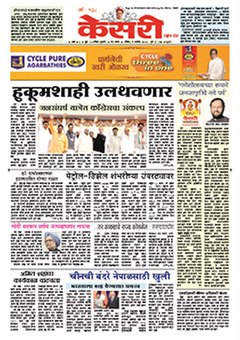Kesari (Marathi newspaper)
 | |
 | |
| Type | Daily newspaper |
|---|---|
| Format | Print, online |
| Owner(s) | Kesari Maratha Trust |
| Founded | 4 January 1881 |
| Political alignment | Centre-Right |
| Language | Marathi |
| Website | www |


Kesari (Marathi: केसरी Sanskrit for Lion) is a Marathi newspaper which was founded in 1881 by Lokmanya Bal Gangadhar Tilak, a prominent leader of the Indian Independence movement. The newspaper was used as a spokes piece for the Indian national freedom movement, and continues to be published by the Kesari Maratha Trust and Tilak's descendants.[1][2][3]
Bal Gangadhar Tilak used to run his two newspapers, Kesari, in Marathi and Mahratta (Run by Kesari-Maratha Trust)[4][5] in English from Kesari Wada, Narayan Peth, Pune. The newspapers were originally started as a co-operative by Chiplunkar, Agarkar and Tilak.
Initial years, editors and writers
The editors of Kesari included a number of freedom fighters and social activists / reformers, including Agarkar (its first editor), Chiplunkar and Tilak. Agarkar left Kesari in 1887 to start his own news paper, Sudharak (The Reformer) after which Tilak continued to run the paper on his own. Narasimha Chintaman Kelkar, a close associate of Tilak, served as editor twice when Tilak was imprisoned in 1897 and 1908.[6]
Kesari Prosecution of 1897
Bal Gangadhar Tilak mentions that the letter he received from Swami Vivekananda must have been destroyed along with many others after the close of the Kesari Prosecution of 1897.[7]
Present day
An online Marathi periodical called The Daily Kesari continues to be published, edited by Lokmanya Balgangadhar Tilak's great grandson, Deepak Tilak.[8]
Kesari wada and Tilak museum
The wada was originally known as Gaikwadwada[9], and owned by Sayajirao Gaikwad III the Maharaja of the Princely state of Baroda. It was not sold to Tilak by the Maharaja in 1905, as per general saying with certain conditions it had given by Maharaja to Tilak .[10]. The original wada (Marathi for courtyard / building) where Tilak published the newspaper still houses the current day offices of Kesari. Along with offices of Kesari, the courtyard contains the Tilak museum and Kesari-Maratha library. These together house mementos of Tilak, including his writing desk, a number of original documents, and the first India national flag which was unfurled by Madame Cama in 1907 in Stuttgart.[11] During Ganapati festival, the Wada is visited by a large number of people.[12][13]
See also
- Latest Marathi News Official site
- List of newspapers in India
- dhankesari
- Dhan kesari
References
- ^ "About the Vice Chancellor - Deepak J.Tilak". tmv.edu.in. Tilak Maharashtra Vidyapeeth. Retrieved 17 June 2014.
- ^ "Retracing the legend of Gangadhar Tilak at Kesariwada". hfghbbitagesites.wordpress.com. Blog - Indian Heritage Sites. Retrieved 17 June 2014.
- ^ Inamdar, Siddhesh (4 January 2010). "Tendency to dumb down journalism disturbing: N. Ram". The Hindu. Pune. Retrieved 7 January 2013.
- ^ "During the independence movement, newspaper 'Kesari' was published by_: - General Knowledge Today". www.gktoday.in.
- ^ Mone (Tilak), Mrs. Geetali Hrishikesh. "The Role of Free Circulation in Optimum Newspaper Development - Ph.D. thesis submission". shodhganga.inflibnet.ac.in. Preface - Shodhganga. Archived from the original on 20 June 2014. Retrieved 17 June 2014.
- ^ Watve, K.N. (1947). "Sri Narasimha Chintaman "Alias" Tatyasaheb Kelkar". Annals of the Bhandarkar Oriental Research Institute: 156–158. JSTOR 44028058.
- ^ "Reminiscences of Swami Vivekananda". www.ramakrishnavivekananda.info.
- ^ "Know your city - Pune". Indian Express. Retrieved 17 June 2014.
- ^ "Gaikwad Wada Photo on Maharashra Government Website". Maharashtra.gov.in.
- ^ HoVB (22 April 2017). "Gaekwad Wada at Pune". History of Vadodara - Baroda. Retrieved 3 September 2019.
- ^ Pal, Sanchari. "Remembering Madam Bhikaji Cama, the Brave Lady to First Hoist India's Flag on Foreign Soil". A better India. Retrieved 28 June 2018.
- ^ "Kesari Wada". maharashtratourism.net. Maharashtra Tourism. Retrieved 17 June 2014.
- ^ "Kesari Wada". punesite.com. Pune Site. Retrieved 17 June 2014.
